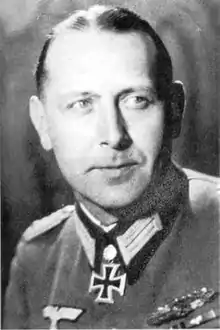Hellmuth Mäder | |
|---|---|
 | |
| Born | 5 July 1908 |
| Died | 12 May 1984 (aged 75) |
| Allegiance | |
| Service/ | German Army |
| Years of service | 1936–45 1956–68 |
| Rank | Generalmajor (Wehrmacht) Generalleutnant (Bundeswehr) |
| Commands held | 7th Panzer Division |
| Battles/wars | World War II |
| Awards | Knight's Cross of the Iron Cross with Oak Leaves and Swords |
| Other work | Bundeswehr |
Hellmuth Mäder (5 July 1908 – 12 May 1984) was a German general during World War II. He was a recipient of the Knight's Cross of the Iron Cross with Oak Leaves and Swords of Nazi Germany.
A native of Rotterode, Thuringia, Hellmuth Mäder joined the Army in 1936 and, by September 1939, was serving as a junior officer with the 34 Infanterie Division. In the spring of 1940, Oberleutnant Mäder commanded the 14th Company of the Infanterie-Regiment 522 in the newly formed 297 Infanterie Division, which was not deployed in the Western campaign. In late 1940, he was appointed commander of the III Battalion / Infanterie Regiment 522 and served in that post during the opening phase of Operation Barbarossa. His division fought under Army Group South, advancing on Kyiv and Rostov, and for his gallantry during the defensive action of winter 1941-1942, Mäder was awarded the Knight's Cross of the Iron Cross on April 3, 1942. In July 1942, he was promoted to Major and took command of Infanterie Regiment 522, which distinguished itself during 6. Armee's drive to the Don, fighting at Kharkiv, the Izyum Pocket, and Voronezh.
Promoted to Oberstleutnant, Mäder led his regiment into Stalingrad, where it was cut off with the rest of the 6. Armee. Hellmuth Mäder led battle groups of his regiment and others during the defensive fighting of December 1942 and January 1943. A serious wound led to his evacuation by air before the final collapse of the 6. Armee at Stalingrad.
While recovering from his wounds Mäder was placed on the Führerreserve until early 1944. Promoted to Oberst, he was given command of the Eingreifbrigade Narwa and returned to the northern sector of the Eastern Front. Here, he was successful in halting a number of localized Soviet attacks before being severely wounded once more. This time, on recovery from his wounds, he was appointed commander of the Heeresgruppen Waffenschule Nord, a weapons training establishment. When the Soviets launched their 1944 summer offensives, he returned to the front, having responsibility for organizing the defense of a vital railway junction at Šiauliai, between Königsberg and Riga. He held it open under heavy attack for two days, allowing retreating German units to pass safely through. For this achievement, he was awarded the Oak Leaves on August 27, 1944.
That autumn, Mäder served briefly as commander of the 7. Panzerdivision, again on the northern Russian front. At the end of 1944, he was given command of the elite Führer Begleit Brigade, a part of Panzerkorps Grossdeutschland. He led it through the Ardennes offensive, and when, in early 1945, the brigade was expanded to become the Führer Grenadier Division, the promoted Generalmajor Mäder was put in command. The new division saw fighting on the eastern front near Stettin before being forced to retreat southwest to the outskirts of Vienna. Here, during the final battles for the Austrian capital, Generalmajor Mäder was awarded the Swords to his Knight's Cross on April 18, 1945.
Although Mäder had surrendered to US forces, he was handed over to the Soviets, who held him in captivity until 1955.
In 1956, Mäder joined the Bundeswehr, serving with the rank of Brigade general and commanding the Infanterieschule Hammelburg. His last rank before retirement was a general lieutenant. In 1974, he was arrested, convicted, and sentenced to two years imprisonment for money he embezzled in his position in the Bundeswehr, as well as for inconsistencies in his expense reports. It was an accusation that he denied until he died on May 12, 1984, in Konstanz.[1]
Awards
- Iron Cross (1939) 2nd Class (27 June 1941) & 1st Class (1 August 1941)[2]
- Knight's Cross of the Iron Cross with Oak Leaves and Swords
- Knight's Cross on 3 April 1942 as Major and commander of the III./Infanterie-Regiment 522[3]
- 560th Oak Leaves on 27 August 1944 as Oberst and leader of the Lehr-Brigade Nord/Heeresgruppe Waffenschule Nord and at the same time combat commander of Schaulen[3]
- 143rd Swords on 18 April 1945 as Generalmajor and commander of the Führer-Grenadier-Division[3]
References
Citations
Bibliography
- Berger, Florian (1999). Mit Eichenlaub und Schwertern. Die höchstdekorierten Soldaten des Zweiten Weltkrieges [With Oak Leaves and Swords. The Highest Decorated Soldiers of the Second World War] (in German). Vienna, Austria: Selbstverlag Florian Berger. ISBN 978-3-9501307-0-6.
- Scherzer, Veit (2007). Die Ritterkreuzträger 1939–1945 Die Inhaber des Ritterkreuzes des Eisernen Kreuzes 1939 von Heer, Luftwaffe, Kriegsmarine, Waffen-SS, Volkssturm sowie mit Deutschland verbündeter Streitkräfte nach den Unterlagen des Bundesarchives [The Knight's Cross Bearers 1939–1945 The Holders of the Knight's Cross of the Iron Cross 1939 by Army, Air Force, Navy, Waffen-SS, Volkssturm and Allied Forces with Germany According to the Documents of the Federal Archives] (in German). Jena, Germany: Scherzers Militaer-Verlag. ISBN 978-3-938845-17-2.
- Thomas, Franz (1998). Die Eichenlaubträger 1939–1945 Band 2: L–Z [The Oak Leaves Bearers 1939–1945 Volume 2: L–Z] (in German). Osnabrück, Germany: Biblio-Verlag. ISBN 978-3-7648-2300-9.